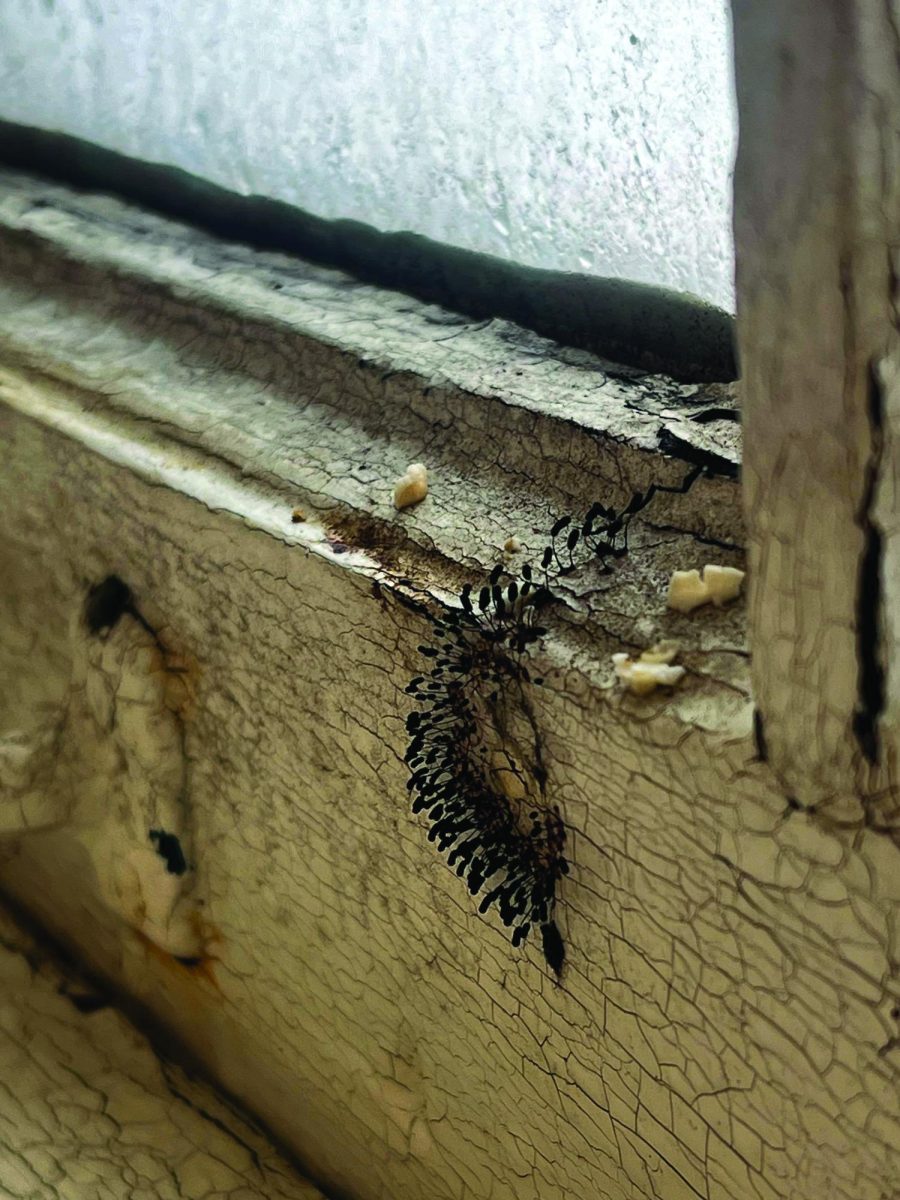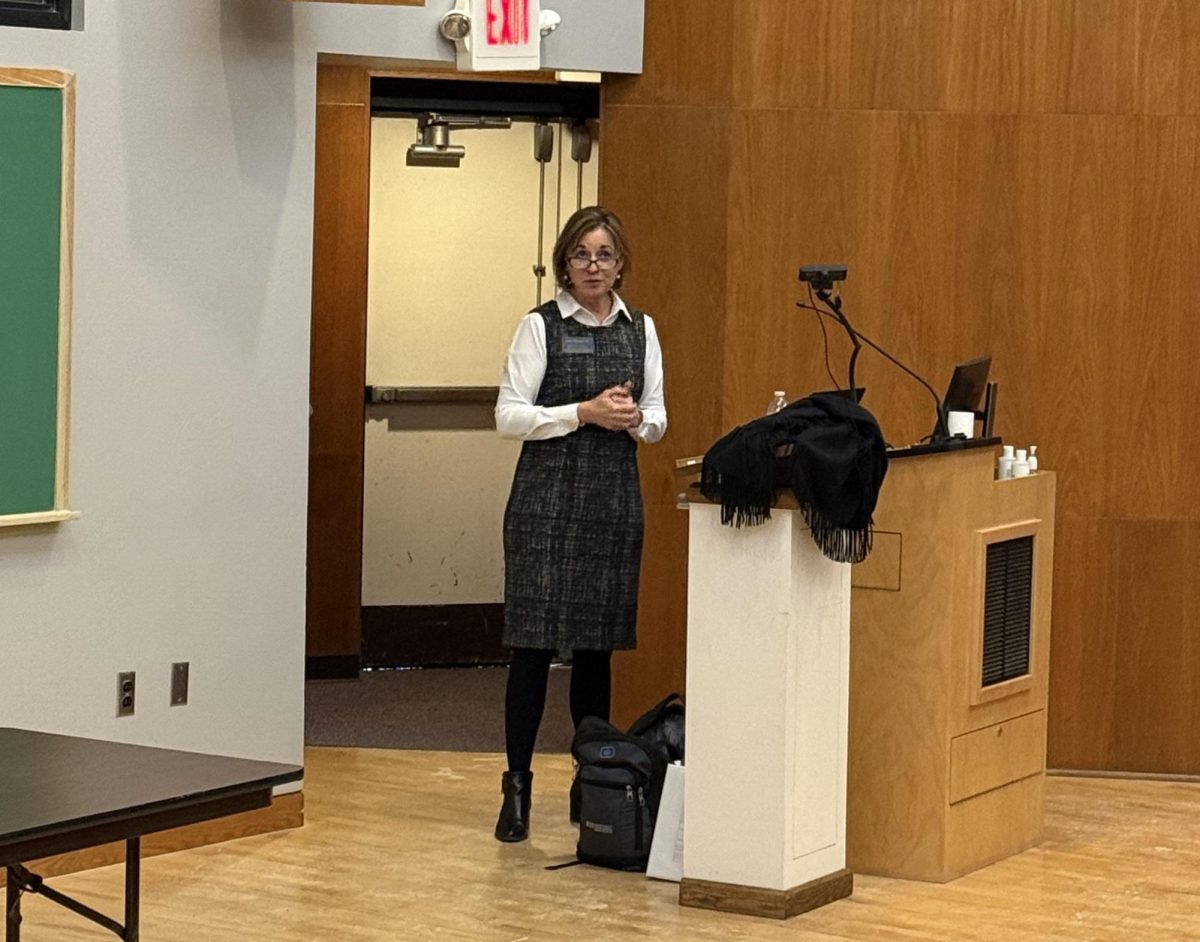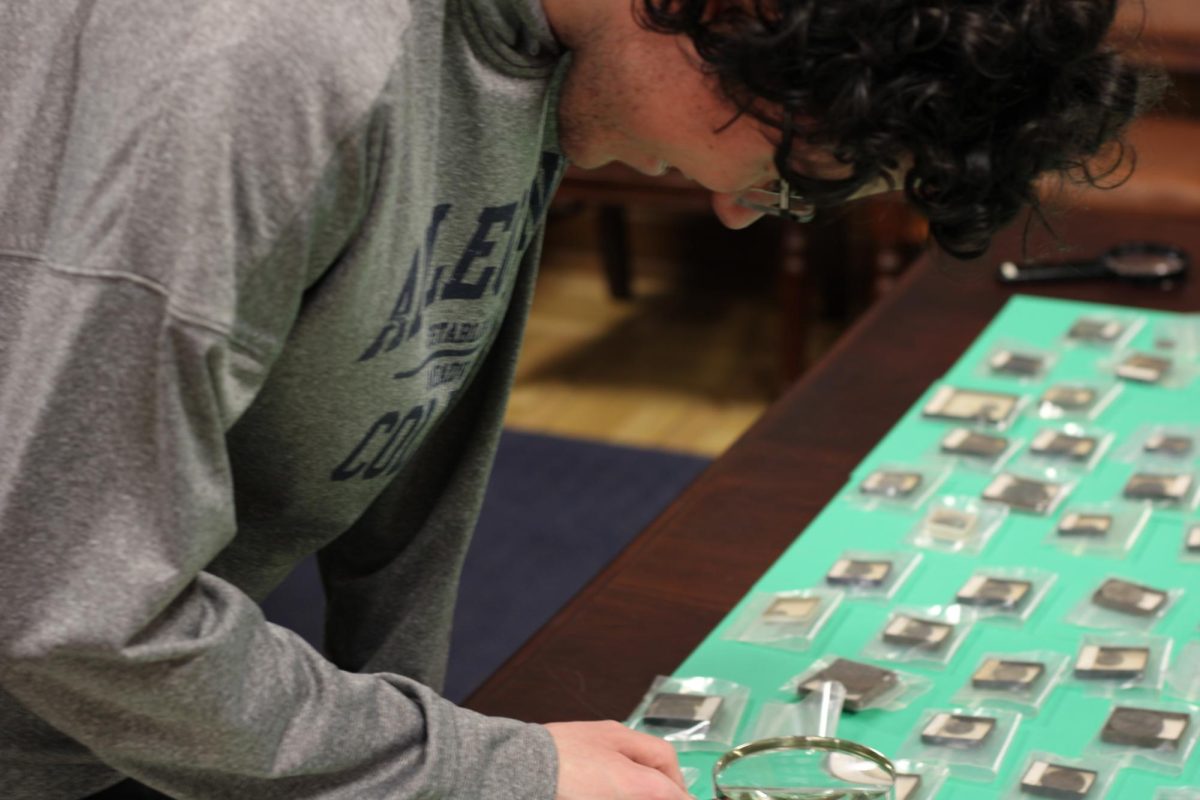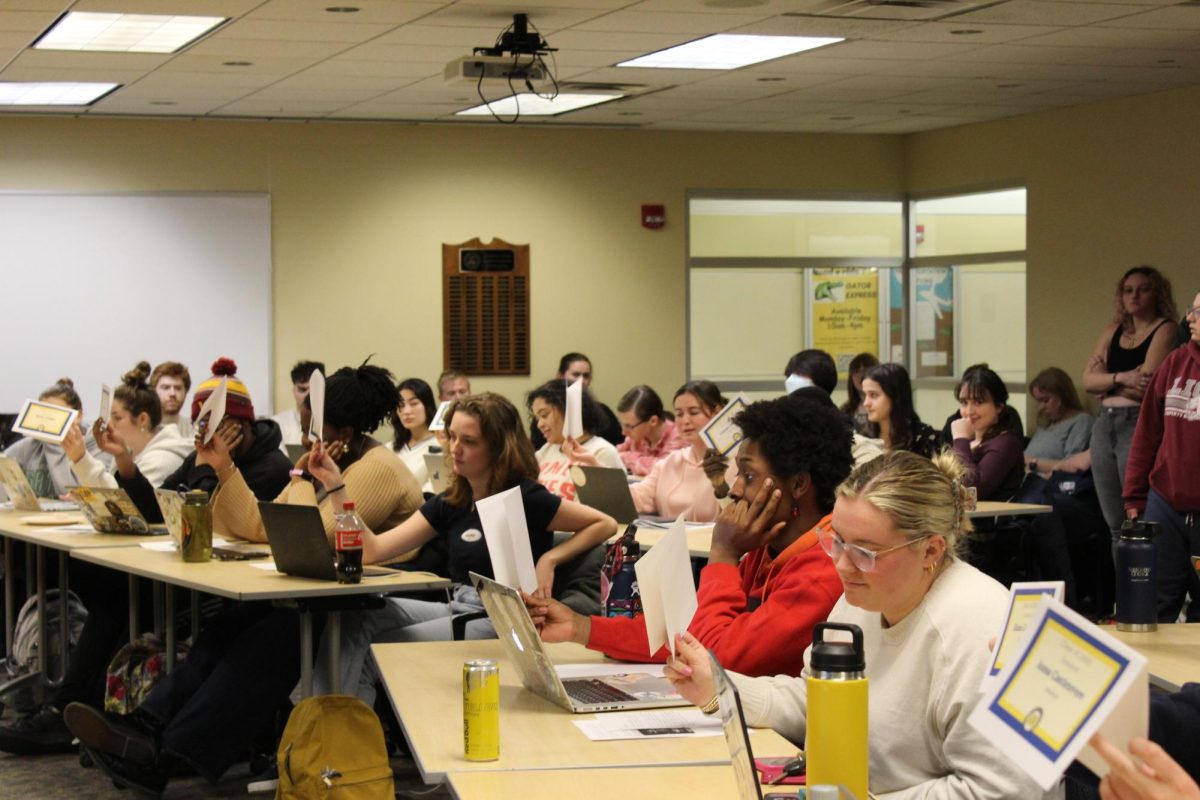Listen up, English majors. An ancient life form has sprouted in Oddfellows Hall.
Professor of English Matt Ferrence noticed it first on Feb. 3.
“It was very hot and humid in the building. And I happened to go downstairs into the bathroom in the old philosophy wing, and I saw on the windowsill a gelatinous mass with what looked like, kind of, pepper flakes in the gelatinous mass,” Ferrence said. “By the next day, because I had decided to visit it again, it had — the gelatinous mass had disappeared. And what was just left were the fruiting stalks of the slime mold.”
Slime molds’ otherworldly appearance may appear threatening, but University of Arkansas plant diagnosticians report that they are completely harmless and usually vanish on their own.
Despite their name and appearance, slime molds are not a type of fungus at all. They’re protists, according to the National Park Service, although scientists have struggled for decades to fit them into a taxonomic category. Their current classification is a catch-all for any organism that definitely has chromosomes and a nucleus, but definitely isn’t a plant, fungus, or animal.
Associate Professor of Biology Margaret Nelson explained that slime molds can be divided into two main groups — cellular and plasmodial — with only the plasmodial variety growing large enough to be conspicuous on a windowsill.
“Some of them can be, yeah, really, really enormous,” Nelson said.
Plasmodial slime molds are so distantly related to the cellular species that Nelson studies that the two types have evolved completely different strategies to find food. But both manage to dissolve common notions of the boundary between ‘individual’ and ‘community.’
Nelson explained that in food-abundant conditions, cellular slime molds live their lives as independent, single celled organisms.
“So here are the individual cells, and then when they starve, they secrete these signals and they attract their neighbors,” Nelson said.
She then explained that thousands of these individuals form a cooperative mass, allowing them to search for food synchronously.
“So you can get like a hundred thousand cells that come together, but they’re called cellular because they maintain their individual,” Nelson said.
As a plasmodial slime mold, the Oddfellows specimen started as a typical microscopic cell. But when it bumped up against another slime mold cell of the same species, the two fused into a single larger cell with two nuclei and one cell membrane. From there it kept growing, expanding until it was multiple centimeters across. The gelatinous phase that first absorbed Ferrence’s attention was one giant cell most likely feeding on microscopic populations of wood-eating bacteria or fungi by engulfing them within its cell membrane. Now, its stalks are producing spores that will initiate a new generation of single-celled plasmoids ready to form their own bacteria-eating supercell.
“Mostly I thought it was gross and not a great sign for the general condition of the building,” Ferrence said. But he snapped a photo anyway, and took to the internet.
“So I put a picture on Facebook, and some of my friends identified it as a likely slime mold, at which point I had my greatest success ever on Bluesky when I posted a picture ‘#amoebozoa,’ because I figured out if it’s a slime mold, it’s an amoebozoa, which I did not know the natural history of until I started looking into it and went viral —viral — on Bluesky with, like, 15 likes,” Ferrence said. “So that’s my massive influence, because for unknown reasons, when I opened a Bluesky account, I started following all the fungus accounts, which is, like, a thing. There’s a whole, like, community of people that take pictures of interesting fungi and molds and lichens and, you know, slime molds, though not exactly related, were part of that.”
For those unfamiliar with Bluesky, Ferrence describes it as “Where everyone has gone, when they fled Twitter for becoming what Twitter became.”
“I just thought it was cool, actually, because at that point, I knew what it was, and it really did dawn on me, ‘oh, I actually have, like, a connection to this sort of bizarre subset of human beings on the planet who are into molds and lichens,’” Ferrence said about the decision to post his observation online.
After witnessing zest for plasmodial life spread among his classes, colleagues and online community, Ferrence reports that he has undergone a change of heart about the Oddfellows slime mold.
“My relationship to the slime mold has shifted quite considerably because, like, truly, my first reaction with it was like, gross, as I said, and a little annoyed, but now, like, I authentically really dig it and kind of love it,” Ferrence said. “Part of my interest in it is because my students were so interested in it, and they, like, helped move me from abject disgust to uncontained enthusiasm that people keep slime mold as pets, apparently.”
Although Ferrence says he does not wish to formally adopt this slime mold, it has become part of his daily routine.
“I have gone to visit the slime mold at least once a day during the work week since I first discovered the slime mold,” Ferrence said. “So I usually, when I walk to work, I walk in through that hallway, so I stop in and check on it.”
Ferrence’s colleagues’ feelings about the slime mold vary in intensity.
“Those who I’ve chatted with about it I think share a kind of bemused interest, and at least one colleague shares my actual fascination with it as a creature itself,” Ferrence said. “I know Professor Miller went to visit the slime mold today, in fact, at my encouragement.”
Despite its rapid initial transformation from blob of goo to forest of stalks, the slime mold has changed little since Ferrence’s first observation.
“I have been waiting for it to change in some dramatic way so I can do a follow-up and it has not yet, so — and I don’t know if it’s dormant or if it’s just like: its plans are different than my plans; its sense of time is different than my sense of time,” Ferrence said.
That may well be the case.
After studies showed that plasmodial slime molds can solve mazes, recognize paths they’ve already traversed and rival humans in constructing the most efficient paths towards enticing destinations, science writer Ferris Jabr mused on the slime mold’s surprisingly sophisticated abilities to evaluate its environment.
“Compared with most organisms, slime molds have been on the planet for a very long time—they first evolved at least 600 million years ago and perhaps as long as one billion years ago,” Jabr wrote in Scientific American. “At this time, no organisms had yet evolved brains or even simple nervous systems. Yet slime molds do not blindly ooze from one place to another—they carefully explore their environments, seeking the most efficient routes between resources. They do not accept whatever circumstances they find themselves in, but rather choose conditions most amenable to their survival.”
If these conditions happen to include a warm, humid windowsill in Oddfellows Hall, Ferrence observes that humans gain an opportunity to more carefully explore their own environment.
“I’m truly kind of struck by how it inspires a curiosity and interest in, sort of, both other people and myself,” Ferrence said. “It’s an organism that is showing up where you don’t expect an organism to show up, and I respect that it’s doing that.”
Nelson celebrated this curiosity.
“It’s just kind of fun to have people enjoying the weird and wonderful variety that exists in the biological world,” Nelson said.
Categories:
Slime mold inhabits Oddfellows Hall
The slime mold protrudes from the men’s bathroom windowsill in Oddfellow Hall’s philosophy wing. The mold has formed fruiting stalks to spread further.
Story continues below advertisement
0
Tags:
More to Discover
About the Contributors

Milo Watson, Layout Editor
Milo Watson is a junior from Delaware. He double-majors in English with a focus in Nonfiction Creative Writing and Environmental Science & Sustainability. This is his first year on staff. He enjoys reading outside.
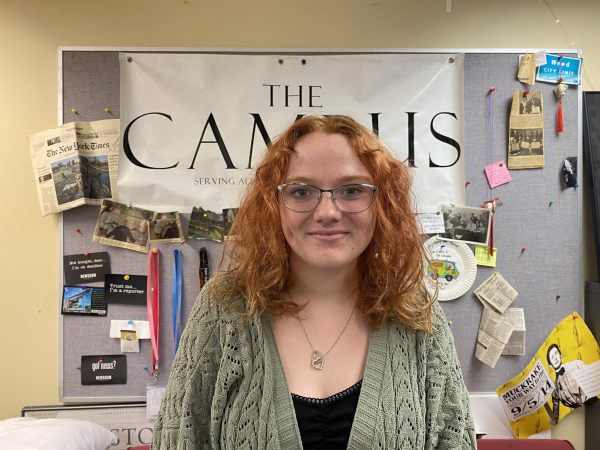
Noell Fritz, Layout Editor
Noell Fritz is a sophomore from Summerville South Carolina. She is majoring in Biology with a double minor in Astronomy and Studio Art. She has been on staff a little less than a year and is a layout editor for the features section. She enjoys kayaking, scuba diving and reading.




